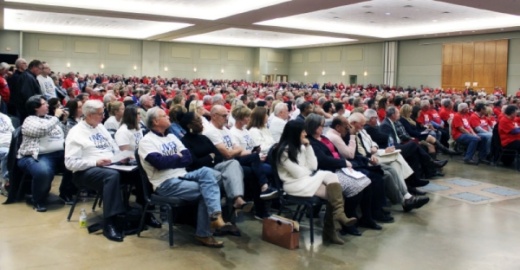With the San Jacinto River Authority board of directors set to vote Feb. 20 on whether to continue lowering the lake in the spring and fall, opposing groups of Lake Houston and Lake Conroe residents have voiced their opinions on the strategy’s effectiveness.
Lake Houston-area officials said seasonally lowering Lake Conroe leads to fewer releases from the dam, which can reduce flooding downstream.
“We’re just asking for a stop-gap measure; we just want some level of reassurance,” Kingwood resident Elizabeth Bolt said. “We had over 3 feet of water in our home that came in the middle of the night [during Hurricane Harvey] with no warning.”
Local residents are imploring the SJRA to continue lowering Lake Conroe until permanent flood-prevention strategies, such as dredging the West Fork of the San Jacinto River and•adding gates to the Lake Houston dam, are done.
Alternatively, Lake Conroe homeowners cited a lack of boat access to the lake and effects on local businesses and property values as reasons to stop lowering the lake.
“I spent my life savings for my wife and I to live on the lake,” Lake Conroe homeowner Jim Phillips said in an email. “The SJRA ... clearly [does not] care about our lake, the businesses or our neighborhoods.”
Benefits of lowering
The SJRA’s temporary measure to seasonally lower Lake Conroe’s water level went into effect in August 2018 as a flood-mitigation strategy in response to Harvey in August 2017.The initiative called for the lake’s water level to be lowered 2 feet in August and September and 1 foot in April and May. The city of Houston also began prereleasing 1 foot of water from Lake Houston when at least 3 inches of rain is predicted.
The strategy is reviewed annually and is authorized by the SJRA and the city of Houston, which owns two-thirds of the water in Lake Conroe. SJRA General Manager Jace Houston said lowering the lake is intended to reduce flooding for residents along the San Jacinto River by increasing capacity to catch rainfall and runoff.
“If the lake is low ... when you go into a storm, it does reduce the amount of water that has to be released downstream,” he said.
The strategy’s effectiveness was tested in a heavy rainstorm May 7-9 and Tropical Storm Imelda on
Sept. 19—both of which occurred during seasonal lowering times. According to rainfall and dam release data from the SJRA, rainfall from the May event pushed Lake Conroe’s lake level from almost a foot below normal pooling level to several inches above the normal level, even with controlled releases happening during the storm.
Briana Gallagher, the project coordinator for the SJRA’s flood management division, said rainfall data for the events depict both sides of the lowering argument.
“If the lake level were at 201 feet when the rainfall came into the reservoir, we would have needed to release more water [in May],” she said.
Nevertheless, the Texas Division of Emergency Management reported 474 single-family structures in Harris County were affected by the storm. However, Gallagher also pointed to Imelda, when the lake sat a little over 2 feet below its normal level and the rainfall on Lake Conroe was not enough to initiate releases, yet the Lake Houston area still flooded.
“It really comes down to location, intensity and the amount of rain that is falling,” she said.
Lake Conroe worries
Lake Conroe residents are demanding an end to the lowering with a “Stop the Drop” campaign, citing negative effects for lakefront homeowners and businesses. They have the support of Conroe City Council; state Rep. Will Metcalf, R-Conroe; Montgomery County commissioners; and the city of Montgomery, per resolutions and letters from the entities.Freedom Boat Club owner John Foster said club members are more hesitant to boat on the lake, and if the lake levels remain low, it could cost his business memberships.
“We have had people that have avoided coming out [on] the lake because they’re worried about the water levels,” he said.
Brian Bondy, the president of the Conroe Lake Conroe Chamber of Commerce, said it could hurt home values.
“If you are paying more for lakefront properties and you can’t access the lake, then your property doesn’t have the same value than it would if you did have access,” he said.
A long-term solution
The Lake Houston Area Chamber of Commerce also launched a “Lives over Levels” campaign, which is fighting for lowering to continue. The strategy is also supported by Humble City Council, Houston Mayor Sylvester Turner and Rep. Dan Huberty, R-Houston.Jenna Armstrong, the president of the Lake Houston Area Chamber of Commerce, said Lake Conroe should continue to be lowered until the $47.1 million Lake Houston dam gate project can be completed in August 2022. It will allow water to be released more quickly from the dam, she said.
While Lake Conroe’s gates are designed to release water at a rate of up to 150,000 cubic feet per second, Lake Houston’s gates can only release water at a rate of 10,000 cubic feet per second, according to a February 2018 report from Harris County and engineering firm Freese and Nichols.
“We have never asked for this to be permanent, nor do we expect it to be permanent,” Armstrong said. “We have asked for it to be in place until we can get permanent projects that allow us to release the water that allow us to be safe.”
This article ran in the February 2020 edition of Lake Houston, Humble, Kingwood. The full e-edition will be available online Feb. 3.




